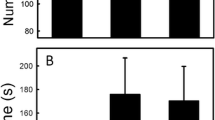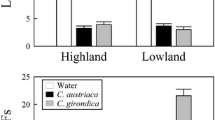Abstract
Responses by the insectivorous, actively foraging scincid lizard, Scincella lateralis, to chemical cues from a plant food favored by herbivorous lizards, its ability to discriminate prey chemicals from control substances, and its relative response to internal and surface prey chemicals were studied experimentally. We presented chemical cues to the lizards on cotton swabs and recorded their tongue-flicks and biting attacks on the swabs. The lizards exhibited significantly greater tongue-flick rates and biting frequencies to prey surface cues than to plant surface chemicals from romaine lettuce, diluted cologne (pungency control), and deionized water. Responses to the plant stimuli did not differ from those to the two control stimuli, in contrast with strong responses to the same plant cues by herbivores. This finding provides the first information suggesting that chemosensory response may be adapted to diet, with responsiveness to plant stimuli evolving de novo in herbivores. Biting and tongue-flicking responses were significantly greater to cricket chemicals than to all other stimuli, among which there were no differences. Thus, the lizards are capable of prey chemical discrimination, which may be ubiquitous among actively foraging lizards. The lizards exhibited more frequent biting and higher tongue-flick rates to internal than surface prey chemicals. Although different methods of stimulus preparation are appropriate for different purposes, we conclude that prey surface chemicals available to foraging lizards are most desirable for studies bearing on location and identification of prey.
Similar content being viewed by others
REFERENCES
Arnold, S. J. 1981a. Behavioral variation in natural populations. I. Phenotypic, genetic and environmental correlations between chemoreceptive responses to prey in the garter snake, Thamnophis elegans. Evolution 35:489-509.
Arnold, S. J. 1981b. Behavioral variation in natural populations. II. The inheritance of a feeding response in crosses between geographic races of the garter snake, Thamnophis elegans. Evolution 35:510-515.
Brooks, G. R. 1963. Food habits of the ground skink. J. Fla. Acad. Sci. 26:361-367.
Brooks, G. R. 1967. Population ecology of the ground skink, Lygosoma laterale (Say). Ecol. Monogr. 37:71-87.
Burghardt, G. M. 1969. Comparative prey-attack studies in newborn snakes of the genus Thamnophis. Behaviour 33:77-114.
Burghardt, G. M. 1970a. Chemical perception in reptiles, pp. 241-308, in J. W. Johnston, D. G. Moulton, and A. Turk (eds.). Advances in Chemoreception, Vol. I. Communication by Chemical Signals. Appleton-Century-Crofts, New York.
Burghardt, G. M. 1970b. Intraspecific geographical variation in chemical food cue preferences of newborn garter snakes (Thamnophis sirtalis). Behaviour 36:246-257.
Burghardt, G. M. 1973. Chemical release of prey attack: extension to naive newly hatched lizards, Eumeces fasciatus. Copeia 1973:178-181.
Burghardt, G. M., and Hess, E. H. 1968. Factors influencing the chemical release of prey attack in newborn snakes. J. Comp. Physiol. Psychol. 66:289-295.
Chiszar, D., Dunn, T. M., and Smith, H. M. 1993. Response of brown tree snakes (Boiga irregularis) to human blood. J. Chem. Ecol. 19:91-96.
Cooper, W. E., Jr. 1994a. Chemical discrimination by tongue-flicking in lizards: a review with hypotheses on its origin and its ecological and phylogenetic relationships. J. Chem. Ecol. 20:439-487.
Cooper, W. E., Jr. 1994b. Prey chemical discrimination, foraging mode, and phylogeny, pp. 95-116, in L. J. Vitt and E. R. Pianka (eds.). Lizard Ecology: Historical and Experimental Perspectives. Princeton University Press, Princeton, New Jersey.
Cooper, W. E., Jr. 1995. Foraging mode, prey chemical discrimination, and phylogeny in lizards. Anim. Behav. 50:973-985.
Cooper, W. E., Jr. 1997. Correlated evolution of prey chemical discrimination with foraging, lingual morphology, and vomeronasal chemoreceptor abundance in lizards. Behav. Ecol. Sociobiol. 41:257-265.
Cooper, W. E., Jr. 1998a. Evaluation of swab and related tests for responses by squamates to chemical stimuli. J. Chem. Ecol. 24:841-866.
Cooper, W. E., Jr. 1998b. Prey chemical discrimination indicated by tongue-flicking in the eublepharid gecko Coleonyx variegatus. J. Exp. Zool. 281:21-25.
Cooper, W. E., Jr., and Alberts, A. C. 1990. Responses to chemical food stimuli by an herbivorous actively foraging lizard, Dipsosaurus dorsalis. Herpetologica 46:259-266.
Cooper, W. E., Jr., and Burghardt, G. M. 1990a. Vomerolfaction and vomodor. J. Chem. Ecol. 16:103-105.
Cooper, W. E., Jr., and Burghardt, G. M. 1990b. A comparative analysis of scoring methods for chemical discrimination of prey by squamate reptiles. J. Chem. Ecol. 16:45-65.
Dearing, M. D. 1993. An alimentary specialization for herbivory in the tropical whiptail lizard Cnemidophorus murinus. J. Herpetol. 27:111-114.
Dial, B. E. 1978. Aspects of the behavioral ecology of two Chihuahuan desert geckos (Reptilia, Lacertilia, Gekkonidae). J. Herpetol. 12:209-216.
Dial, B. E., and Schwenk, K. 1996. Olfaction and predator detection in Coleonyx brevis (Squamata: Eublepharidae), with comments on the functional significance of buccal pulsing in geckos. J. Exp. Zool. 276:415-424.
Dial, B. E., Weldon, P. J., and Curtis, B. 1989. Chemosensory identification of snake predators (Phyllorhynchus decurtatus) by banded geckos (Coleonyx variegatus). J. Herpetol. 23:224-229.
Halpern, M. 1992. Nasal chemical senses in reptiles: structure and function, pp. 423-523, in C. Gans and D. Crews (eds.). Hormones, Brain, and Behavior, Biology of the Reptilia, Vol. 18, Physiology E. University of Chicago Press, Chicago.
Hamilton, W. J., Jr., and Pollack, J. A. 1961. The food of some lizards from Fort Benning, Georgia. Herpetologica 17:99-106.
Lewis, T. H. 1951. The biology of Leiolopisma laterale (Say). Am. Midl. Nat. 95:232-240.
Nicoletto, P. F. 1985. The roles of vision and the chemical senses in predatory behavior of the skink, Scincella lateralis. J. Herpetol. 19:487-491.
Vitt, L. J., and Cooper, W. E., Jr. 1986. Foraging and diet of a diurnal predator (Eumeces laticeps) feeding on hidden prey. J. Herpetol. 20:408-415.
Winer, B. J. 1962. Statistical Principles in Experiment Design. McGraw-Hill, New York.
Wright, S. P. 1992. Adjusted P-values for simultaneous inference. Biometrics 48:1005-1013.
Zar, J. H. 1995. Biostatistical Analysis, Third ed. Prentice Hall, Englewood Cliffs, New Jersey.
Author information
Authors and Affiliations
Rights and permissions
About this article
Cite this article
Cooper, W.E., Hartdegen, R. Discriminative Response to Animal, But Not Plant, Chemicals by an Insectivorous, Actively Foraging Lizard, Scincella lateralis, and Differential Response to Surface and Internal Prey Cues. J Chem Ecol 25, 1531–1541 (1999). https://doi.org/10.1023/A:1020880614708
Issue Date:
DOI: https://doi.org/10.1023/A:1020880614708




